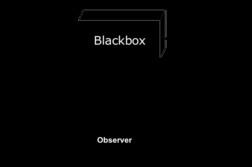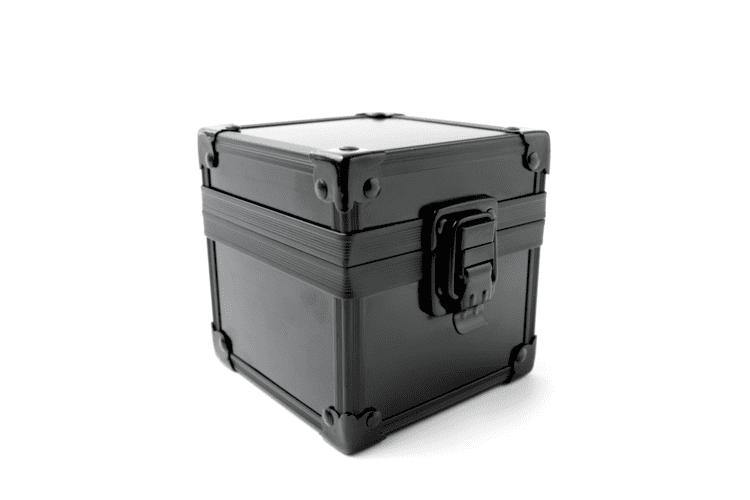 | ||
What s inside a black box
In science, computing, and engineering, a black box is a device, system or object which can be viewed in terms of its inputs and outputs (or transfer characteristics), without any knowledge of its internal workings. Its implementation is "opaque" (black). Almost anything might be referred to as a black box: a transistor, an algorithm, or the human brain.
Contents
- What s inside a black box
- Airplane black boxes explained
- History
- System theory
- Recording of observed states
- Modeling
- Testing the black box model
- Other theories
- Adoption in humanities
- Examples
- Other uses of the term
- References

To analyse something, as an open system, with a typical "black box approach", only the behavior of the stimulus/response will be accounted for, to infer the (unknown) box. The usual representation of this black box system is a data flow diagram centered in the box.

The opposite of a black box is a system where the inner components or logic are available for inspection, which is most commonly referred to as a white box (sometimes also known as a "clear box" or a "glass box").

Airplane black boxes explained
History
The modern term "black box" seems to have entered the English language around 1945. In electronic circuit theory the process of network synthesis from transfer functions, which led to electronic circuits being regarded as "black boxes" characterized by their response to signals applied to their ports, can be traced to Wilhelm Cauer who published his ideas in their most developed form in 1941. Although Cauer did not himself use the term, others who followed him certainly did describe the method as black-box analysis. Vitold Belevitch puts the concept of black-boxes even earlier, attributing the explicit use of two-port networks as black boxes to Franz Breisig in 1921 and argues that 2-terminal components were implicitly treated as black-boxes before that.
In cybernetics, a full treatment was given by Ross Ashby in 1956. A black box was described by Norbert Wiener in 1961 as an unknown system that was to be identified using the techniques of system identification. He saw the first step in self-organization as being to be able to copy the output behavior of a black box. Many other engineers, scientists and epistemologists, as Mario Bunge, used and perfected the black box theory in the 1960s.
System theory
The black box is an abstraction representing a class of concrete open system which can be viewed solely in terms of its stimuli inputs and output reactions:
The constitution and structure of the box are altogether irrelevant to the approach under consideration, which is purely external or phenomenological. In other words, only the behavior of the system will be accounted for.
The understanding of a black box is based on the "explanatory principle", the hypothesis of a causal relation between the input and the output, and:
Recording of observed states
An observer makes observations over time. All observations of inputs and outputs of a black box can be written in a table with the form:
in which, at each of a sequence of times, the states of the box’s various parts, input and output, are recorded. Thus, using an example from Ashby, examining a box that has fallen from a flying saucer might lead to this protocol:
Thus every system, fundamentally, is investigated by the collection of a long protocol, drawn out in time, showing the sequence of input and output states. From this there follows the fundamental deduction that all knowledge obtainable from a Black Box (of given input and output) is such as can be obtained by re-coding the protocol (the observation table); all that, and nothing more.
If the observer also controls input, the investigation turns into an experiment (illustration), and hypotheses about cause and effect can be tested directly.
When the experimenter is also motivated to control the box, there is an active feedback in the box/observer relation, promoting what in control theory is called a feed forward architecture.
Modeling
The modeling process is the construction of a predictive mathematical model, using existing historic data (observation table).
Testing the black box model
A developed black box model is a validated model when black-box testing methods ensures that it is, based solely on observable elements.
With backtesting, inputs for past events (not used in the "modeling effort") are entered into the model to see how well the output matches the known results.
Other theories
Black box theories are things defined only in terms of their function. The term black box theory is applied to any field, philosophy and science or otherwise where some inquiry or definition is made into the relations between the appearance of something (exterior/outside), i.e. here specifically the thing's black box state, related to its characteristics and behaviour within (interior/inner).
Specifically, the inquiry is focused upon a thing that has no immediately apparent characteristics and therefore has only factors for consideration held within itself hidden from immediate observation. The observer is assumed ignorant in the first instance as the majority of available data is held in an inner situation away from facile investigations. The black box element of the definition is shown as being characterised by a system where observable elements enter a perhaps imaginary box with a set of different outputs emerging which are also observable.
Adoption in humanities
In humanities disciplines such as philosophy of mind and behaviorism, one of the uses of black box theory is to describe and understand psychological factors in fields such as marketing when applied to an analysis of consumer behaviour.
The black box theory of consciousness states that the mind is fully understood once the inputs and outputs are well-defined.
Examples
Black Box theory is, however, even wider in application than these professional studies:
The child who tries to open a door has to manipulate the handle (the input) so as to produce the desired movement at the latch (the output); and he has to learn how to control the one by the other without being able to see the internal mechanism that links them. In our daily lives we are confronted at every turn with systems whose internal mechanisms are not fully open to inspection, and which must be treated by the methods appropriate to the Black Box.
(...) This simple rule proved very effective and is an illustration of how the Black Box principle in cybernetics can be used to control situations that, if gone into deeply, may seem very complex.
A further example of the Black Box principle is the treatment of mental patients. The human brain is certainly a Black Box, and while a great deal of neurological research is going on to understand the mechanism of the brain, progress in treatment is also being made by observing patients' responses to stimuli.
